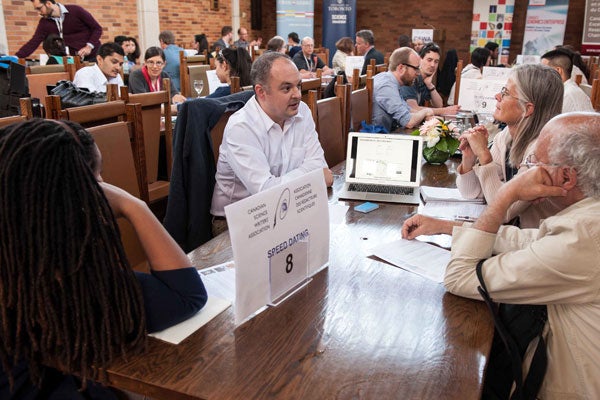
Speed dating, Dragon’s Den and scientists by the dozen at CSWA conference
Published: June 11, 2014
Did you know that wood residue can be used to manufacture automobile engine covers or that honeybees can recognize their half-sisters living two hives distant?
If you did, there’s a good chance you took part in the Science Speed Dating session at the Canadian Science Writers' Association (CSWA) annual meeting hosted by the University of Toronto Science Engagement from June 5 to 8.
The conference featured more than two dozen researchers from U of T and other Toronto institutions who participated in lectures, panel discussions, facility tours and sessions such as speed dating, where scientists had five minutes to interest writers in their research, and a facsimile of the Dragon’s Den television show that allowed journalists to decide whether a researcher’s pitch sounded viable or not.
Participants were enthusiastic about the offerings.
“I’m not sure that there’s any ONE thing that I enjoyed most,” said Altaira Northe, a medical writer for the AboutKidsHealth program at SickKids Hospital. “The sessions were so rich.
"I just love being around scientists and research in general; it has a certain energy and excitement that can’t be matched elsewhere.”
Other panels showcased science communicators and provided professional development opportunities for attendees, something Melinda Knox, one of the editors of the research magazine at Queen’s University, appreciated.
“The social media panel featuring three 'gurus' in the field was particularly interesting, especially the discussions centred on how to measure 'success' on these platforms,” said Knox via email. “Sometimes it’s not a numbers game; instead you need to evaluate if your audience is actually engaged with the content you are putting out.”
Meeting attendees also had the opportunity to tour various university and teaching hospital research facilities, including the Toronto Rehabilitation Institute and the U of T Institute for Aerospace Studies (UTIAS). Photo tweets from UTIAS flew fast and furiously, with participants exclaiming about the opportunities to try a flight simulator, watch flying robotic vehicles and visit the wind tunnel.
Professor Ray Jayawardhana, the senior advisor on science engagement to President Meric Gertler, and the driving force behind bringing the CSWA meeting to the University of Toronto, said the appeal of the panels, tours, and interactive sessions showcased the breadth of research taking place at U of T.
“The scientists were able to connect the research to people’s lives, which makes for compelling stories,” he said.
Jayawardhana, an astrophysicist, was delighted to be able to bring scientists and communicators together in a setting that allowed for meaningful conversation.
“The intimacy and the immediacy of the sessions were really valuable,” he said. “Communicators were able to ask the scientists direct questions and get new insights into a variety of frontier research topics.”
Professor Ron Deibert, director of U of T's Citizen Lab, delivered the luncheon address on the second day of the conference, and he held the audience spellbound with his analysis of the growing power of the state in cyberspace and the way they are changing the face of online communications. Participants were reluctant to curtail their questions in order to attend the afternoon sessions.
“It was illuminating to hear Professor Deibert highlight the impact 9/11 had on the governance of cyberspace and, more important, the implications for journalists and for our day-to-day lives,” said Helen Lasthiotakis, assistant dean of arts and science, who was instrumental in organizing the program.
“I think that the U of T's commitment to scientists communicating better – yes, I am speaking about the Science Leadership Program – showed itself in the quite accomplished way its professors and researchers spoke and described their research,” said Stephen Strauss, CSWA president. “My guess is that members of CSWA who are information officers may well go back to their institutions with a sense that they want to make their professors and grad students as good communicators as those they saw at the U of T.”
If so, the hosts will have accomplished one of their goals: “reinforcement that for science and science engagement, the University of Toronto is the place to be.”



